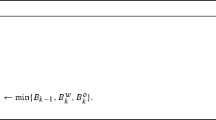Abstract
We show that a theorem of Smale can be used to unify the polynomial-time bound proofs of several of the recent interior algorithms for linear programming and convex quadratic programming.
Similar content being viewed by others
References
D. Bayer and J.C. Lagarias, “The nonlinear geometry of linear programming, I. Affine and projective scaling trajectories, II. Legendre transform coordinates and central trajectories,”Transactions of the American Mathematical Society 2 (1989) 499–526.
J. Curry, “On zero finding methods of higher order from data at one point,”Journal of Complexity 5 (1989) 219–237.
M.B. Daya and C.M. Shetty, “Polynomial barrier function algorithms for linear programming,” School of Industrial and Systems Engineering, Georgia Institute of Technology (Atlanta, GA, 1987).
M.B. Daya and C.M. Shetty, “Polynomial barrier function algorithms for convex quadratic programming,” School of Industrial and Systems Engineering, Georgia Institute of Technology (Atlanta, GA, 1988).
P. Deuflhard and G. Heindl, “Affine invariant convergence theorems for Newton's method and extensions to related methods,”SIAM Journal of Numerical Analysis 16 (1979) 1–10.
D. Goldfarb and S. Liu, “An O(n 3 L) primal interior point algorithm for convex quadratic programming,”Mathematical Programming 49 (1991) 325–340.
C.C. Gonzaga, “An algorithm for solving linear programming problems in O(n 3 L) operations,” in: N. Megiddo, ed.,Progress in Mathematical Programming, Interior Point and Related Methods (Springer, New York, 1988) pp. 1–28.
M. Kim, “On approximate roots and rootfinding algorithms for a complex polynomial,”Mathematics of Computation 51 (1988) 707–719.
M. Kojima, S. Mizuno and A. Yoshise, “A primal-dual interior point method for linear programming,” in: N. Megiddo, ed.,Progress in Mathematical Programming, Interior Point and Related Methods (Springer, New York, 1988) pp. 29–47.
M. Kojima, S. Mizuno and A. Yoshise, “A polynomial-time algorithm for a class of linear complementarity problems,”Mathematical Programming 44 (1989) 1–26.
N. Megiddo, “Pathways to the optimal set in linear programming,” in: N. Megiddo, ed.,Progress in Mathematical Programming, Interior Point and Related Methods (Springer, New York, 1988) pp. 131–158.
N. Megiddo and M. Shub, “Boundary behaviour of interior point algorithms in linear programming,”Mathematics of Operations Research 14 (1989) 97–146.
R.C. Monteiro and I. Adler, “Interior path following primal-dual algorithms, I. Linear programming, II. Convex quadratic programming,”Mathematical Programming 44 (1989) 27–66.
J. Renegar, “A polynomial-time algorithm, based on Newton's method, for linear programming,”Mathematical Programming 40 (1988) 59–93.
W.C. Rheinboldt, “On a theorem of S. Smale about Newton's method for analytic mappings,”Applied Mathematics Letters 1 (1988) 69–72.
H.W. Royden, “Newton's method,” Department of Mathematics, Stanford University (Stanford, CA, 1986).
S. Smale, “Newton's method estimates from data at one point,” in:The Merging of Disciplines in Pure, Applied, and Computational Mathematics (Springer, New York-Berlin, 1986) pp. 185–196.
S. Smale, “Algorithms for solving equations,”Proceedings of the International Congress of Mathematicians (Berkeley, CA, 1986) pp. 87–121.
G. Sonnevend, “An ‘Analytic Center’ for polyhedrons and new classes of global algorithms for linear (smooth, convex) programming,” in:Lecture Notes in Control and Information Sciences No. 84 (Springer, Berlin, 1986) pp. 866–876.
P. Vaidya, “An algorithm for linear programming that requires O(((m+n)n 2 +(m+n) 1.5 n)L) arithmetic operations,”Proceedings of the Nineteenth ACM Symposium on the Theory of Computing (1987) pp. 29–38.
Y. Ye, “Further developments on an interior algorithm for convex quadratic programming,” unpublished manuscript.
Ju. E. Nesterov and A.S. Nemirovsky,Self-Concordant Functions and Polynomial-Time Methods in Convex Programming (Central Economic and Mathematical Institute, USSR Academy of Sciences, Moscow, 1989).
Author information
Authors and Affiliations
Additional information
This research is supported by NSF grants.
Rights and permissions
About this article
Cite this article
Renegar, J., Shub, M. Unified complexity analysis for Newton LP methods. Mathematical Programming 53, 1–16 (1992). https://doi.org/10.1007/BF01585691
Received:
Revised:
Issue Date:
DOI: https://doi.org/10.1007/BF01585691




